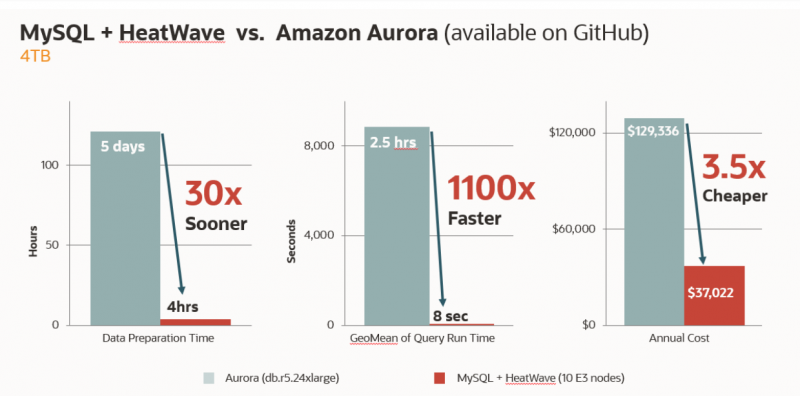 BIG DATA
BIG DATA
 BIG DATA
BIG DATA
 BIG DATA
BIG DATA
A commonly understood principle in the tech world is that over time, every industry ultimately gets disrupted. It’s MySQL’s turn.
The popular database technology was due for a shakeup after nearly 26 years. That disruption has recently been fueled by Oracle Corp., which released MySQL HeatWave in December. Other major cloud players and a growing ecosystem of smaller firms are seeking to raise MySQL’s profile in the future role of database tech for enterprise information technology.
In the past, MySQL was great for transactions, but data usually had to be moved via the so-called extract/transfer/load or ETL process for analytics. Transfers take time, and time is money. If the database got too big, performance would deteriorate.
“What MySQL HeatWave does is solve all of these problems,” Marc Staimer, president of Dragon Slayer Consulting, said in an interview with SiliconANGLE. “You have faster transactions resulting in lower compute time. Because the compute is done primarily in-memory, lower performing object storage works great and costs less. And since there are no ETLs required, there are no ETL service costs, third-party costs or internal costs.”
Oracle claims it has been able to improve MySQL by addressing a number of key technology factors. HeatWave uses an in-memory engine optimized for vector processing, it’s built on a massively parallel architecture enabled by a massively partitioned architecture, and it has installed new algorithms that power its columnar structure and scalability.
One of HeatWave’s strengths, according to Nipun Agarwal, Oracle’s vice president of MySQL and advanced technologies, is that users of the MySQL cloud database can run transaction processing and analytics without having to ETL data anywhere. That allows customers to make decisions in real time and database changes are immediately visible for queries, according to Agarwal.
“If you can now do the analysis in real time and make that part of the business process, then you have eliminated the need to do more work to check and finish that business process; the brainwork has been done,” said David Floyer, chief technical officer of SiliconANGLE sister market research firm Wikibon Inc. “They are making MySQL much more useful.”
Oracle has backed up its makeover of MySQL with benchmarks, publicly accessible on GitHub, which offer comparisons with cloud competitors, most notably Amazon Web Services Inc. According to this information, half a terabyte of MySQL HeatWave is 400 times faster than other offerings in terms of latency.
Oracle claims that moving to a larger data size, at 4 terabytes, MySQL is 1,100 times faster than AWS Aurora and three times faster than the fastest shape of AWS Redshift — and at one-third the cost. Oracle says it ran these benchmarks on the latest shapes of AWS Redshift, the most optimized configurations with AWS’ scripts, and the same with Aurora based on their guidelines, scripts and latest release.
SiliconANGLE reached out to AWS on Oracle’s assertions and is still awaiting a response. Below is a sample of Oracle’s posted comparison posted on GitHub.

By publishing these benchmarks, Oracle has signaled a willingness to challenge the status quo in the enterprise database world. AWS, Google LLC and Microsoft’s Azure all offer MySQL database services. What will this mean for the competitive database market moving forward?
Prior to the recent launch of HeatWave, Oracle had already experienced competitive heat in the database market. Amazon.com Inc. Chief Technology Officer Werner Vogels made no attempt to hide a shutdown of the last Oracle database running Amazon’s fulfillment operation in 2019.
In the previous year, AWS Chief Executive Officer Andy Jassy sparred with Oracle Chairman and Chief Technology Officer Larry Ellison over claims that Amazon was highly dependent on Oracle’s database technology. “Uh huh, keep talkin’ Larry,” was part of Jassy’s response.
Oracle has also been the subject of an ad campaign in 2020 by competitor MemSQL, which attacked the database giant for being an inflexible and expensive solution for modern enterprise workloads.
Yet Oracle has also formed its own partnerships with at least one major cloud player. The company announced a cloud interoperability alliance with Microsoft Azure two years ago and followed that with a database collaboration in 2020.
“It’s going to accelerate some of those partnerships with Oracle, such as the one it has with Microsoft Azure,” Staimer said.
Oracle’s direct challenge to Amazon Aurora and the technological advances it announced with HeatWave could spur the major cloud providers to take action as well, especially if the new MySQL database demonstrates traction among customers.
“I expect that what AWS will try to do is improve the speed and connection between Aurora, which is row-based, and Redshift, which is column-based,” Floyer said. “The three major cloud players will be pushed to improve MySQL. My view is they will have to do something because this type of capability is vital for business process automation.”
The MySQL saga is not confined solely to moves on the chess board by multibillion-dollar cloud providers. A combination of community developed forks and startups are angling to disrupt the database industry as well.
The commercialization of MySQL by Sun Microsystems and its subsequent acquisition by Oracle resulted in the formation of separate MySQL database companies, including open-source Percona and the formation of the MariaDB Foundation in 2012.
MariaDB was developed as open-source software within a relational database to provide an SQL interface for accessing data. Wikipedia, WordPress.com and Google are among its notable users.
In a statement provided to SiliconANGLE for this story, MariaDB Corp. Chief Product Officer Jags Ramnarayan offered his view of Oracle’s most recent moves in the MySQL space.
“I’d like to congratulate Oracle MySQL for joining us thinking that analytics are important and an enterprise-class database should include the capability – we did so in 2016,” Ramnarayan said. “For too long, Oracle reserved this feature to their proprietary database.”
He added that “in true Oracle style,” its implementation is proprietary and reserved to Oracle Cloud, not available in any other public cloud or on-prem. “We believe everyone should have access to powerful analytics and secure transactions together in one database,” he said. “That’s why support for any workload – transactions, analytics and hybrid – is available in our open-source database.”
Others in the database industry are taking the position that Oracle’s HeatWave solution essentially misses the point. Improving MySQL is less about increasing processor power and memory and more about strengthening the database query. That’s the premise that led to the creation of QIKR Inc., a startup that fuses artificial intelligence and machine learning with open-source databases and analytics applications to eliminate query performance problems.
“Oracle is coming at it from the hardware side of the problem, relying on clusters and in-memory,” Steve Topper, chief executive officer of QIKR, said in an interview with SiliconANGLE. “What Oracle is doing is nothing new; in-memory is not new, clusters are not new. It’s not really an I/O or read problem, it’s a bad SQL, poorly written queries, garbage in/garbage out problem.”
Topper’s point underscores a key element behind renewed interest in MySQL among tech companies large and small. Structured query language forms the basis for being able to ask a question in a database and get the answer accurately, quickly and with minimal cost. In today’s IT landscape, that means paying close attention to one important interface driving the modern enterprise: the application.
“The reality is you’ve got to follow the application,” Topper said. “Databases are the heartbeat of virtually all important applications, but the query – the fundamental request for information – is its soul.”
With its recent investment in advances for MySQL and HeatWave, Oracle is charting its own course in the database market. Not everyone is prepared to follow its path, but a shakeup in the database world is spurring new technologies that can only benefit enterprise customers in the long run.
Support our mission to keep content open and free by engaging with theCUBE community. Join theCUBE’s Alumni Trust Network, where technology leaders connect, share intelligence and create opportunities.
Founded by tech visionaries John Furrier and Dave Vellante, SiliconANGLE Media has built a dynamic ecosystem of industry-leading digital media brands that reach 15+ million elite tech professionals. Our new proprietary theCUBE AI Video Cloud is breaking ground in audience interaction, leveraging theCUBEai.com neural network to help technology companies make data-driven decisions and stay at the forefront of industry conversations.